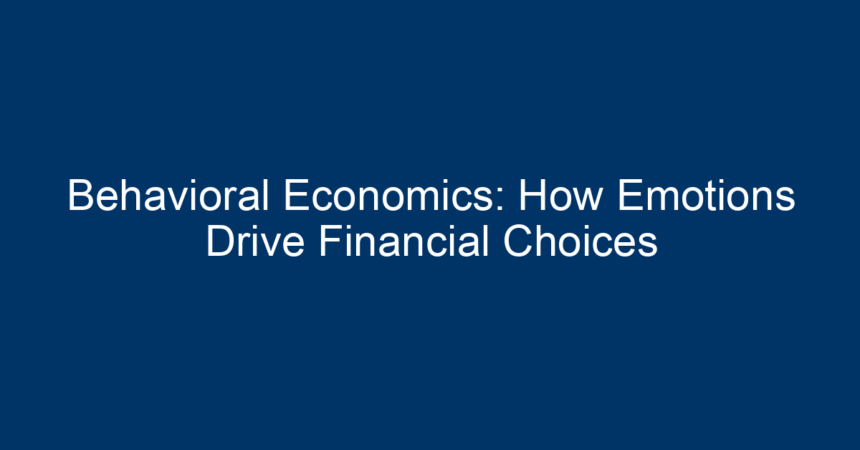In the world of finance, decisions aren’t made solely based on logic and cold calculations. Instead, they are deeply influenced by a myriad of emotional factors that weave their way through every financial choice we make. This phenomenon is the essence of behavioral economics — a field that merges insights from psychology with economics to explain why individuals often act against their best interests. Understanding how emotions drive financial choices can empower individuals to make better, more informed decisions. This article will explore the fascinating intersection of emotions and economics, providing insights that can lead to more effective financial management.
Understanding Behavioral Economics
What is Behavioral Economics?
Behavioral economics challenges the traditional economic assumption that humans are rational actors. Instead, it posits that our decisions are often influenced by cognitive biases and emotional states. Key figures like Daniel Kahneman and Amos Tversky have pioneered research in this area, revealing how our thinking is often skewed by factors ranging from societal influences to personal emotions.
The Emotional Component of Financial Decision-Making
At its core, behavioral economics suggests that emotions play a crucial role in how we perceive value, risk, and reward. This emotional influence can lead to various phenomena, such as loss aversion and overconfidence, which can significantly impact our financial choices.
Key Emotional Drivers in Financial Choices
1. Loss Aversion
Loss aversion refers to the psychological phenomenon where individuals prefer to avoid losses rather than acquiring equivalent gains. This concept is foundational in behavioral economics and explains why many people make conservative financial choices, such as hoarding cash or undervaluing investment opportunities. For example, the fear of losing money can deter investors from engaging in potentially profitable but riskier ventures.
2. Fear and Anxiety
Financial markets are particularly volatile, and the emotions of fear and anxiety can lead to irrational decision-making. During market downturns, investors may panic and sell off their assets at a loss, driven by the fear of losing their investment. Understanding this emotional trigger can help individuals remain calm and strategic during turbulent times.
3. Overconfidence Bias
On the flip side, overconfidence can lead individuals to overestimate their knowledge or predict future market movements with unwarranted certainty. This often leads to overly aggressive investments and can result in significant financial losses. In behavioral economics, recognizing when overconfidence is influencing a financial decision can be paramount to achieving better outcomes.
4. The Role of Social Influence
Our financial choices are not made in a vacuum. Social influences, such as peer pressure or the desire to conform, can significantly impact our decisions. Behavioral economics teaches us that individuals may choose to invest in specific stocks or assets simply because everyone else is doing so — a classic example of herd behavior. Understanding how social factors affect our choices can lead to more autonomous and informed decision-making.
Behavioral Biases in Financial Decision-Making
1. Anchoring
Anchoring occurs when individuals rely too heavily on the initial piece of information they receive. For example, an investor might anchor to a stock’s previous high price, leading them to undervalue the stock even if it has strong future potential. This behavioral bias can hinder objective analysis and result in suboptimal financial decisions.
2. Mental Accounting
Mental accounting refers to the mental categorization of money. Individuals often treat money differently based on its source or intended use, rather than its overall value. For instance, people might splurge with a bonus while being overly frugal with their regular income. Recognizing this bias can help individuals make more rational financial decisions that encompass their total wealth rather than isolated windfalls.
3. Sunk Cost Fallacy
The sunk cost fallacy is another common bias in behavioral economics, where individuals continue to invest in a losing proposition simply because they have already invested time or money into it. Understanding this fallacy can guide individuals to reevaluate their investments and make more objective financial choices rather than clinging to past losses.
Strategies to Overcome Emotional Biases in Financial Decision-Making
1. Educate Yourself
Knowledge is power. By understanding the principles of behavioral economics and the emotional factors influencing your decisions, you can gain greater control over your financial choices. Consider taking courses in finance or reading books on behavioral economics to deepen your understanding.
2. Create a Financial Plan
A well-structured financial plan can serve as a roadmap, reducing reliance on emotional decision-making. By setting clear goals and strategies, individuals are less likely to deviate from their intended path based on momentary emotional states.
3. Practice Mindfulness
Mindfulness practices, such as meditation and reflective journaling, can help individuals cultivate greater awareness of their emotional responses. This awareness allows for more rational decision-making during financial choices, particularly in high-stress situations.
4. Seek Professional Guidance
Working with a financial advisor can provide an objective perspective, helping individuals to avoid common emotional pitfalls. Advisors can guide clients through turbulent financial landscapes, ensuring that decisions are grounded in logic and comprehensive analysis rather than fleeting emotions.
Concluding Thoughts
Behavioral economics offers profound insights into the emotional underpinnings of our financial decisions. Understanding how emotions like fear, loss aversion, and social influences can skew our judgment allows individuals to make sounder financial choices. By recognizing cognitive biases and implementing strategic strategies, we can navigate the complexities of our financial lives with greater clarity and confidence.
By harnessing the insights gained from behavioral economics, individuals can transform their financial decision-making processes into more effective, objective, and ultimately successful strategies. Empowering ourselves with knowledge and cultivating emotional awareness will lead to better financial outcomes and a healthier relationship with money.
Incorporating these insights into everyday financial decision-making can pave the way for a more secure and prosperous future. So take a step back, embrace the lessons of behavioral economics, and watch how transforming your financial mindset can lead to meaningful changes in your financial journey.



